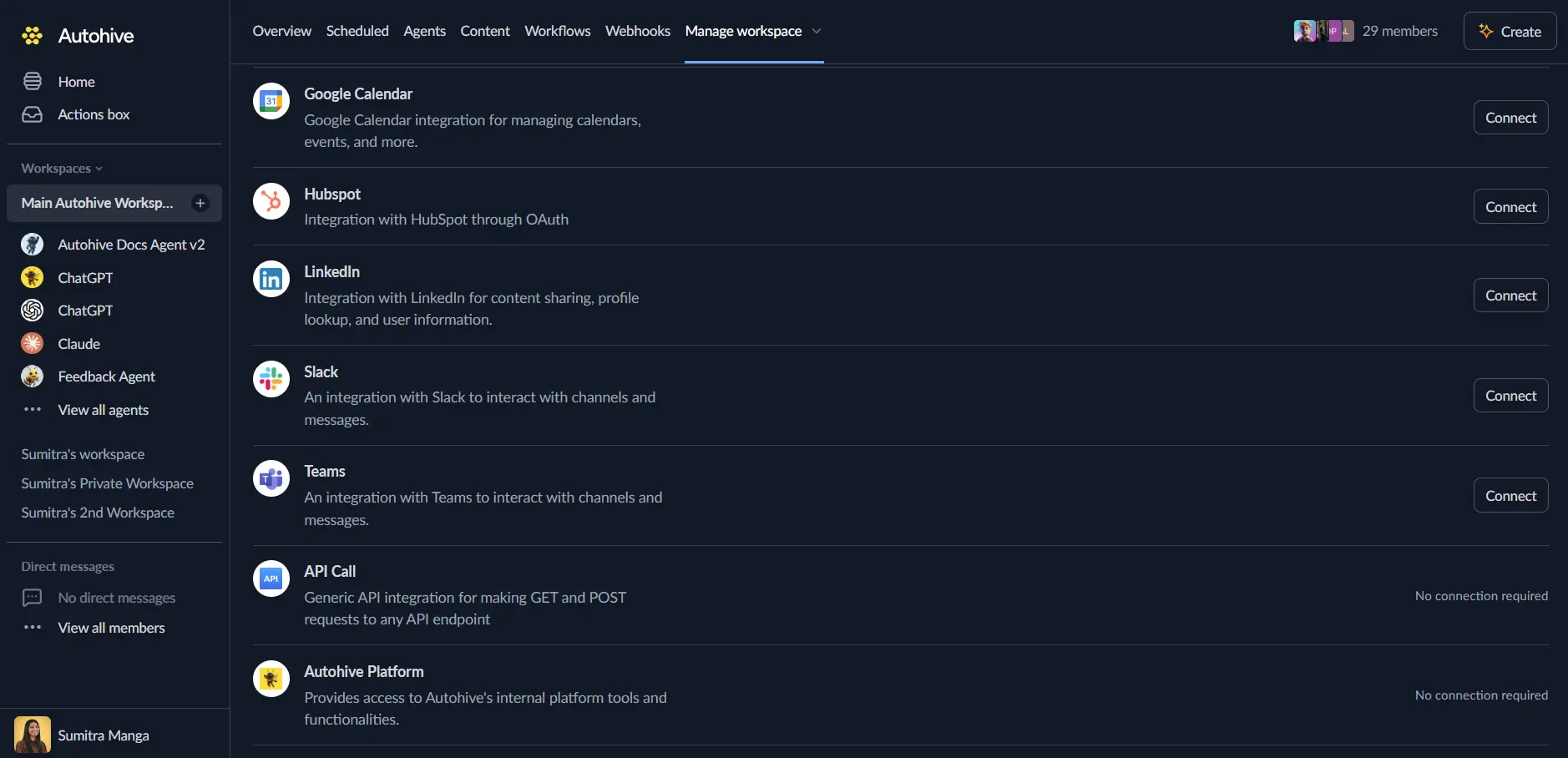Telegram
The Autohive Telegram integration connects your Telegram bot with Autohive’s automation platform, enabling:
- Message automation - Send automated messages to Telegram chats, groups, and channels
- Bot management - Monitor and control your Telegram bot operations and status
- Real-time messaging - Receive and respond to incoming Telegram messages through automation workflows
- Multi-format support - Send messages with HTML, Markdown, and MarkdownV2 formatting
- Chat monitoring - Poll for new messages and updates from your bot’s conversations
- Cross-platform integration - Connect Telegram with other services in your automation workflows
Install the integration
-
Create a Telegram Bot (if you don’t have one):
- Open Telegram and search for
@BotFather - Send
/newbotcommand and follow instructions - Choose a name and username for your bot
- Copy the bot token provided by BotFather
- Open Telegram and search for
-
Log in to Autohive and navigate to Your user profile > Connections or Your workspace -> Manage workspace
-
Locate the Telegram Integration card and click Connect

-
Enter your Bot Token in the authentication field
-
Confirm installation - your Telegram bot will be connected to Autohive
Use the integration
You can now use the integration with your agents, workflows and scheduled tasks!
- Follow our Create your first agent guide on how to create an agent.
- In the ‘Agent settings’, scroll down to the ‘Add capabilities’ section and turn on the Telegram capability. You can choose what individual Telegram capabilities to turn on and off.
- Once the settings have been selected, begin prompting the agent of the workflow you’d like to achieve with Autohive and Telegram!
Available capabilities
Message Operations
- Send Message: Send text messages to specific chats, groups, or channels using chat IDs or usernames
- Rich Formatting: Support for HTML, Markdown, and MarkdownV2 formatting in messages
- Multi-Chat Messaging: Send messages to multiple recipients simultaneously through automation
- Scheduled Messaging: Deliver messages at specific times through Autohive workflows
Bot Management
- Get Bot Info: Retrieve information about your bot including ID, name, and username
- Bot Status Monitoring: Check bot connectivity and operational status
- Authentication Verification: Confirm bot token validity and permissions
Message Monitoring
- Get Updates: Retrieve new messages and updates from your bot’s conversations
- Real-Time Polling: Monitor incoming messages with configurable polling intervals
- Message Processing: Handle incoming messages through automated workflows
- Update Management: Process different types of Telegram updates and events
Automation Triggers
- New Message Triggers: Automatically respond to incoming messages based on content or sender
- Scheduled Notifications: Send regular updates, reminders, and status messages
- Event-Driven Messaging: Send messages triggered by external events or conditions
- Cross-Platform Integration: Coordinate Telegram messaging with other platform integrations
Key features
Telegram Bot API Integration
- Full support for Telegram’s official Bot API
- Secure authentication using bot tokens
- Real-time message delivery and reception
- Support for all Telegram chat types (private, groups, channels)
Rich Message Formatting
- HTML: Use HTML tags for bold, italic, links, and structured content
- Markdown: Classic markdown formatting for simple text styling
- MarkdownV2: Advanced markdown with additional formatting options
- Plain Text: Simple text messages without formatting
Chat Management
- Send messages using chat IDs (numeric) or usernames (@username)
- Support for private chats, group chats, and broadcast channels
- Handle different chat types with appropriate permissions
- Manage bot interactions across multiple conversations
Real-Time Communication
- Polling-based message retrieval with configurable intervals
- Long polling support for efficient real-time updates
- Message queuing and delivery management
- Automated response capabilities
Common use cases
Customer Support
- Provide automated customer support through Telegram bots
- Send support ticket updates and notifications
- Handle frequently asked questions automatically
- Escalate complex queries to human agents
Business Notifications
- Send system alerts and monitoring notifications
- Deliver order confirmations and shipping updates
- Share business metrics and KPI reports
- Broadcast company announcements
Personal Automation
- Send reminder notifications and calendar alerts
- Deliver news updates and weather forecasts
- Monitor home automation systems
- Share personal productivity metrics
Team Communication
- Coordinate team activities and project updates
- Send deployment notifications to development teams
- Share automated reports and status updates
- Facilitate team collaboration and information sharing
Getting chat IDs
To send messages to specific chats, you’ll need their chat IDs:
For Private Chats
- Start a conversation with your bot
- Use the “Get Updates” action to see incoming messages
- Extract the chat ID from the message data
For Groups and Channels
- Add your bot to the group or channel
- Grant appropriate permissions (send messages)
- Use the chat ID or @username for targeting
Using Usernames
- For public channels: Use
@channelnameformat - For public groups: Use
@groupnameformat - Private chats require numeric chat IDs
Telegram integration best practices
Bot Configuration
- Use descriptive bot names and usernames
- Set appropriate bot descriptions and about text
- Configure bot commands and help information
- Regularly update bot profile and settings
Message Content
- Keep automated messages clear and actionable
- Use appropriate formatting for better readability
- Include relevant context and information
- Avoid spamming users with excessive messages
Security Considerations
- Keep your bot token secure and private
- Don’t share bot tokens in public repositories
- Regularly rotate bot tokens if compromised
- Monitor bot usage for unusual activity
Disconnect the integration
Important: Disconnecting stops data synchronization but preserves existing data in both systems.
- Navigate to Your user profile -> Connections or Your workspace -> Manage workspace
- Find the Telegram Integration
- Click Disconnect and confirm
Data Impact: Existing data remains unchanged in both systems, but sync stops and Autohive loses Telegram bot access.
Remove the bot
From Telegram:
- Remove your bot from groups and channels
- Revoke the bot token through @BotFather if needed
- Delete the bot entirely using @BotFather’s
/deletebotcommand